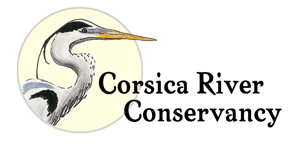The Conservancy works with ShoreRivers to weekly sample and assess water quality between April and October each year. Measuring dissolved oxygen, nutrient pollution, algae, and clarity reveal the overall health of our waterways and progress toward protecting and restoring local rivers.
From 2005 to 2014 Conservancy volunteers sampled five points along the main stem, or tidal, Corsica from May through October: Red Nun 2; Red Nun 4; Red Nun 6; Sycamore Point; and the WoodenBridge. In 2015, that testing was transitioned to ShoreRivers in order to have a more coherent and comparable grading system. CRC volunteers also take part in the ShoreRivers program. ShoreRivers, and its predecessor the Chester River Association, has been testing the Corsica non-tidal tributaries for 20 years. It publishes an annual report card for the Corsica and other Eastern Shore rivers, which can be found here https://www.shorerivers.org/report-card. Water quality testing is now done at three points–the upper, middle, and mouth of the river. The following parameters are measured at one foot and at depth: Dissolved Oxygen (mg/l), Water Temperature (oC), Temperature compensated Conductivity (mS/cm), Salinity (ppt), pH, Secchi Disk Water Clarity (m), and Enterococci (CFU).
Measured Parameters
Dissolved Oxygen (DO)
This is a very important measure of water quality. Most aquatic organisms (e.g., fish, crabs, oysters) require oxygen to survive. DO concentrations below 5 mg/l can stress these organisms. DO levels of around 1 mg/l can result in fish kills.
Water Temperature
Water temperature is another variable affecting suitability of the waterway for aquatic organisms. If water temperatures are consistently higher or lower than average, organisms can be stressed and may even have to relocate to areas with a more suitable water temperature. Water temperature is a product of warming from the sun and air temperature.
Salinity
Salinity in the Bay and its tributaries comes from the ocean. Therefore, areas closer to the ocean have higher salinities. During periods of low precipitation and river flow, salinity increases as it intrudes further up the Bay and its tributaries, while during wetter periods, salinity decreases. Salinity cycles related to the tides may also be evident in these graphs as salinity increases during flood tides and decreases during ebb tides. Salinity levels are important to aquatic organisms, as some organisms are adapted to live only in brackish or salt water, while others require fresh water. If the salinity levels get too high, the health of freshwater fish as well as grasses in the river can be affected.
pH
pH measures the acidity of the water. A neutral pH is 7; lower numbers indicate higher acidity, while higher numbers indicate more alkaline conditions. pH can be affected by salinity (higher salinities tend to buffer pH in the 7-8 range). Photosynthesis by aquatic plants (like in Susquehanna Flats) and algal blooms can raise the pH over 8 in low salinity waters.
Secchi Depth
Secchi depth is a measure of the clarity of the water. Secchi depth is measured using a circular plate, called a Secchi Disk, which is divided into quarters painted alternately black and white. The Secchi Disk is lowered into the water until it is no longer visible, and that depth is measured. Secchi depth values that are high indicate clearer water. Turbid waters typically appear cloudy thereby allowing less light to penetrate through the water. Turbidity is often due to excessive algal growth. However, turbidity can also increase due to land run-off and shore-line erosion, pollution, and resuspension of bottom sediments. Highly turbid waters tend to prevent the growth of submerged aquatic vegetation (SAV) which provides DO to the water column and critical habitat for many fish and invertebrate species.
Enterococci
Enterococci levels are an indicator of harmful bacteria levels in the water. Enterococci levels are reported as Colony Forming Units/100ml (CFU/100ml) Anything below 100 units is considered safe for frequent full body contact (e.g., swimming). Anything below 500 units is considered safe for infrequent casual water contact (e.g., canoeing, kayaking). Harmful bacteria levels are usually highest during the first 48 hours after a heavy rain which washes pollution into the river.
Although not consistently measured in the Corsica, the health of underwater grasses or submerged aquatic vegetation (SAV), is critical for aquatic life. The Virginia Institute for Marine Sciences tracks SAV at three points in the Chester River. Their reporting can be found here https://www.vims.edu/research/units/programs/sav/access/maps/index.php
